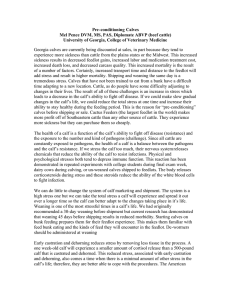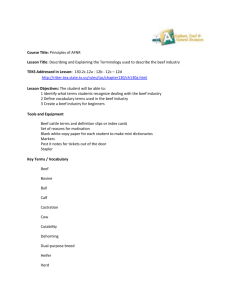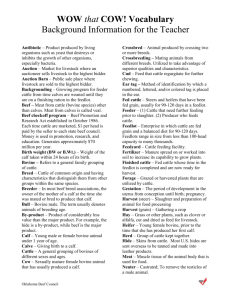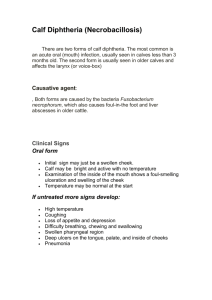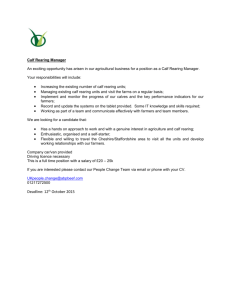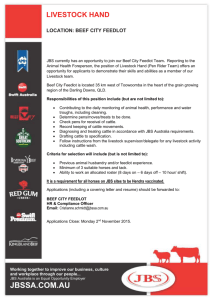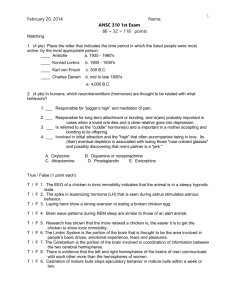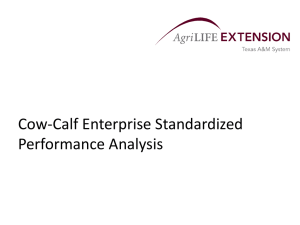4H Beef Worksheet
advertisement
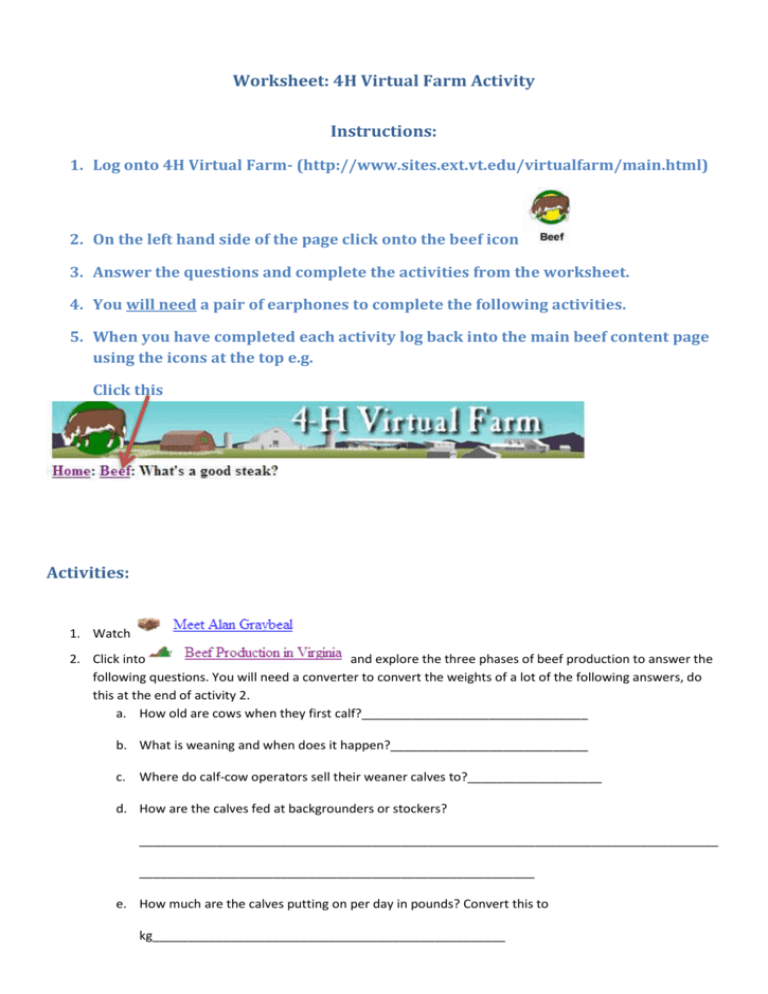
Worksheet: 4H Virtual Farm Activity Instructions: 1. Log onto 4H Virtual Farm- (http://www.sites.ext.vt.edu/virtualfarm/main.html) 2. On the left hand side of the page click onto the beef icon 3. Answer the questions and complete the activities from the worksheet. 4. You will need a pair of earphones to complete the following activities. 5. When you have completed each activity log back into the main beef content page using the icons at the top e.g. Click this Activities: 1. Watch 2. Click into and explore the three phases of beef production to answer the following questions. You will need a converter to convert the weights of a lot of the following answers, do this at the end of activity 2. a. How old are cows when they first calf?________________________________ b. What is weaning and when does it happen?____________________________ c. Where do calf-cow operators sell their weaner calves to?___________________ d. How are the calves fed at backgrounders or stockers? __________________________________________________________________________________ ________________________________________________________ e. How much are the calves putting on per day in pounds? Convert this to kg__________________________________________________ f. How heavy are the claves when they are finished here and at what age? Convert this to kg__________________________________________________ g. Define what a feedlot is: __________________________________________________________________________________ __________________________________________________________________________________ h. What is the weight conversion per day for animals in the feedlot? Convert this to kg per day_________________________________________________ i. How long are the cattle in the feedlot for?__________________________________ j. How old and heavy are they? Convert this to kg______________________________ 3. Click into Use the links up the top to answer the following questions. a. Define what marbling is? __________________________________________________________________________________ ________________________________________________________ b. What does colour indicate?______________________________________________ c. What does marbling do?_________________________________________________ d. What does fat do?______________________________________________________ e. Where is seam fat found and what is it? __________________________________________________________________________________ ________________________________________________________ f. Carry out the virtual steak judging contest 4. Click into a. Look at the slideshow to complete the missing parts of the Nitrogen cycle in the following systems diagram: b. List 3 ways nitrogen is important in the above system: 1_________________________________________________________________________________ 2_________________________________________________________________________________ 3_________________________________________________________________________________ 5. Click into a. How many calves can a cow have in a year (presuming they are singles not twins etc.)? ___________ b. Silage is composed of which part of the corn plant?________________________________________ How many compartments does a cows’ stomach have and what are there names? _______________ R_ _ _ _ ; R _ _ _ _ _ _ _ _ ; O _ _ _ _ _; & A _ _ _ _ _ _ _ c. If an animal is sold for $1.20/kg at the sale yards; and it weighs 652kg. How much will it make? $________________________ 6. Click into to complete the following questions a. From a 1200 pound steer approximately how much waste is there? ________________________ b. What are examples of this waste? _______________________________ c. Is it used? ____________________________________________________ d. What are the hides used for?___________________________________________ e. Name two things/diseases hormones from cattle blood are used to treat in humans? __________________________________________________________________________________ __________________________________________________________________________________ f. What is gelatin? Give an example of what it is used in? __________________________________________________________________________________ __________________________________________________________________________________ g. Name four products beef fat is used for, name 2 household products and 2 products in transportation? __________________________________________________________________________________ __________________________________________________________________________________ h. What is beef protein mainly used for? __________________________________________________________________________________ 7. Click into a. Match the terms with their definitions by drawing a line. Term Definitions Backgrounding grass that has been cut, dried, and stored for feeding later. It is put into bundles called bales that can be either small rectangles or rolls. Feedlot a female bovine that has had a calf. She usually has her first calf at 2 years of age. Calf any plant that cattle may eat. It usually means pasture or hay. a bull that has been castrated so he cannot sire calves. Hay the male bovine that is able to sire (be the father) of calves Steer a place where cattle are put into smaller pens or lots and feed is brought to them Heifer a management system for a weaned calf. In this operation system the weaned calf is put in a lot and harvested feed is brought to him. He is allowed to grow for several months before being sent to the feedlot. Pasture is a management system for a weaned calf. In this operation the weaned calf (6 to 10 months old) is put on pasture and allowed to grow for several more months. Stocker forage preserved by fermentation in a silo, pit, or stack, usually in chopped form A young bovine, usually from the time of birth up until about 6 to 10 months of age when the animal is weaned. Bull a field full of grass that cattle eat on their own Forage Cow a female bovine that has not had a calf. a management operation where young animals are separated from their mothers to make them learn how to eat feed and stop drinking milk Silage Weaning


